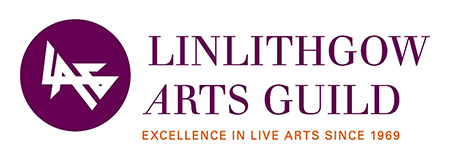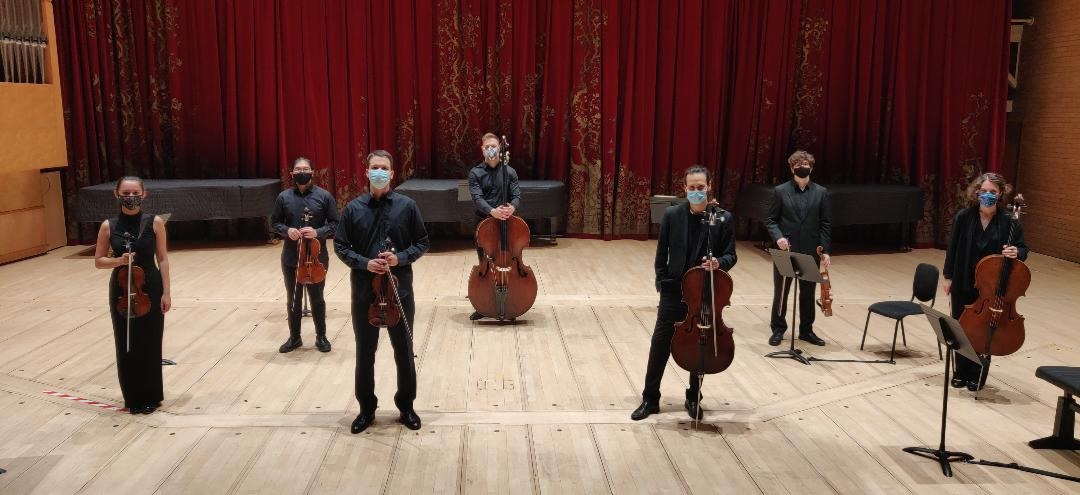We have joined with several other Scottish music societies in sponsoring a concert by the Broen Ensemble, a group of young Scottish musicians (and Tunnell Trust Prize-winners) who were to have been part of this year’s programme.
The concert, for string septet, features Tchaikovsky’s “Souvenir of Florence” and “Metamorphosen”, by Richard Strauss.
The on-line recording is available exclusively to these music societies, including Linlithgow Arts Guild, for the next 3 months, after which it will be promoted more widely by the performers while remaining open to our members for the rest of 2021. We are giving access to members and recent former members of Linlithgow Arts Guild. We will also make this available to any new members who join during this period.
The Broen Ensemble
Broen Ensemble is a young and exciting string ensemble based in Scotland. Formed in 2017 they strive to perform works that are less well-known or rarely played, alongside the more familiar masterpieces. This ambition led them to work with exceptional musicians such as Greg Lawson, Robert Irvine, György Déri and Edward McGuire whose new cello concerto is going to be premiered by the ensemble.
As winners of the Tunnell Trust Award 2019 they were set to have their first tour in Scotland at the end of the year. In 2020 the ensemble was invited to perform alongside the Maxwell Quartet and Isabel Charisius at the Loch Shiel Festival as featured Young Artists. Other festivals they appeared at include the Edinburgh Festival Fringe and the Glasgow Cathedral Festival which gave them the opportunity to open the Lunchtime Concert Series at the University of Glasgow in 2019.
The size of the group changes from quartet to large ensemble which allows them to be more creative when choosing their repertoire. To support them in their work, the Royal Conservatoire of Scotland held the ensemble's first concert and later engaged them for a three-year recital and ballet collaboration commitment which included performing at the opening of the Solheim Cup. Recognising their success, Chamber Music Scotland (formerly Enterprise Music Scotland) invited them to perform at their Showcase Concert and they now feature the ensemble on their website.
Members of the Broen Ensemble when not performing together work with some of the best orchestras in the UK such as the Scottish Chamber Orchestra, BBC Scottish Symphony Orchestra, BBC Symphony Orchestra, London Symphony Orchestra, Birmingham Royal Ballet, Royal Scottish National Orchestra and Welsh National Opera.
Players:
Violins: Dániel Máté Mészöly and Michelle Dierx
Violas: Theodore Chung Lei and Edward Keenan
Cellos: Balazs Renczes and Madelyn Kowalski
Double Bass: Ben Burnley
Metamorphosen was written by Richard Strauss in the closing months of World War 2, from his beloved villa in Garmisch-Partenkirchen. It mourns the destruction of culture, including so many opera houses, the cities of Dresden, Weimar, and Munich, and especially the Goethehaus in Frankfurt am Main.
Strauss had begun work on a choral setting of Goethe's poem Niemand wird sich selber kennen (No one can know himself) when he received a commission for a string work from Paul Sacher, conductor of the Collegium Musicum of Zürich. Strauss extracted ideas from the now-abandoned choral work and incorporated them into Metamorphosen.
The work is deeply felt, serious, and profound; the 80-year-old master had lost none of his touch. The composition is laid out in three continuous sections, which are built from four melodic ideas. The opening chromatic phrase in the cellos is followed by the second idea, a descending theme, from the fourth and fifth violas. The third subject, identified by an octave leap and leisurely triplets reminiscent of a fragment from King Marke's monolog in Wagner's Tristan und Isolde, is introduced by first and second violas. These three themes intertwine and build to a climax in the opening Adagio. In the central Agitato - più allegro, violas present the fourth theme, a stepped idea. As this section progresses, it becomes increasingly contrapuntally complex with mounting tension until the climax, the focal point of the whole work, is reached. The tension subsides, and the closing Adagio, with its themes, returns.
In the last few bars, double-basses play the opening of the Funeral March from Beethoven’s Eroica Symphony, while the upper strings counter with Strauss's 'metamorphosis'. Tellingly, over the Funeral March, Strauss wrote In memoriam!
Souvenir de Florence was written by Tchaikovsky in 1886 when the St. Petersburg Chamber Music Society made him an honorary member. In gratitude, he promised to write a string sextet for the society.
Tchaikovsky loved Florence and he went there for rest and relaxation several times during his life. The main theme of the Adagio was penned there and more preparatory sketches were added during his visit in the winter of 1890. Despite his feelings for Florence, this tribute to it contains essentially nothing characteristically Florentine or even Italian; indeed, its flavour is more Russian than Italian. The composition was completed in Russia between June and August, 1890. Tchaikovsky revised the last two movements during 1891 and 1892.
With this work, Tchaikovsky achieved his goal of writing a sextet for two violins, two violas, and two cellos in a way that gives all six instruments virtually equal prominence. Having completed it, Tchaikovsky wrote to his patroness, Nadezhda von Meck, that he had composed it with much pleasure and enthusiasm and very little effort, and that he hoped that it would please her.
The opening Allegro con spirito, in triple meter, begins energetically and presents a sonata structure, but with an extended coda based on material from the central development section; increased tempi add to the excitement. In the Adagio cantabile e con moto, in ABA form, violin and cello present an exquisitely tender duet. The Allegretto moderato movement has a markedly Russian flavour and derives its energy from a powerful rhythmic sequence. The Allegro vivace finale is strongly polyphonic, and Tchaikovsky positively revels in counterpoint; this magnificent movement rounds off a unique chamber work from a Russian genius.

